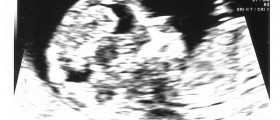Miscarriage, also known as spontaneous abortion, in the second trimester of pregnancy is not so common, although there are some risk factors. The second trimester of pregnancy is considered to be from the 12th to the 20th week of fetal gestation.
The majority of miscarriages happen within the first twelve weeks, sometimes at the beginning of pregnancy when a woman is not aware of the fact that she had conceived and lost her baby. Miscarriages that occur in the first or at the start of the second-trimester account for between 15 and 20 percent of all pregnancies. Any miscarriage that occurs after twenty weeks of pregnancy is termed a stillbirth.
Causes
In some cases, miscarriage may happen in the first trimester, but is detected during screening at the beginning of the second trimester, and that is considered a missed miscarriage. The most common cause of second-trimester miscarriage is a chromosome problem that occurs in the fetus.

Apart from that weak cervix is a frequent cause of loss of a baby during the second trimester. Uterine defects or clotting disorders, as well as previous spontaneous abortion, can all lead to miscarriage during the second trimester of pregnancy.
Weak Cervix
Weak cervix is softened and weaker than the normal cervix, and it may begin dilating and opening too early in the pregnancy. Some women are born with weak cervix, while some may have it because of the surgical procedure on the cervix. This surgery may be performed because of abnormal pap smears that required biopsies, multiple abortions, or D&C procedures.
Weak cervix may start to dilate without causing any symptoms, and as the weight of a growing fetus puts pressure on it causing it to dilate more which can result in unexpected pregnancy loss. In women with an increased risk for miscarriage due to a weak cervix, a doctor may recommend cerclage which is a stitch in the cervix.
Uterine Defects
Miscarriage in the second trimester can also be caused by uterine defects. Uterine defects include bicornuate uterus or heart-shaped uterus and uterine didelphys characterized by the uterus divided in two. Uterine didelphys can lead to the inability of the uterus to grow and expand as the pregnancy progresses. Uterine abnormalities can be surgically treated to prevent pregnancy loss.
Maternal Illness
Mothers affected with some illnesses may not be able to carry a full-term infant. These illnesses include kidney, heart, blood pressure, and clotting disorders. High blood pressure in pregnancy may lead to preeclampsia which is high blood pressure and the presence of protein in the urine.
Women with clotting disorders such as antiphospholipid syndrome, lupus anticoagulant, or anticardiolipin antibody syndrome are at high risk for recurrent miscarriages. These conditions may be treated with blood thinning medications.
- A true second trimester loss should be considered a unique entity, and an appropriate evaluation is indicated. Pregnancy loss is considered a miscarriage when it occurs before 20 weeks' gestation; after this time it is considered a stillbirth. Nevertheless, there is considerable overlap between these definitions, and definitions vary by state.
- Cervical cerclage can be considered in women with three or more unexplained second trimester losses or preterm deliveries and cervical change before viability.
- Combined unfractionated heparin and aspirin may reduce pregnancy loss by 54 percent in women with antiphospholipid antibody syndrome and previous pregnancy loss.
- Providing support and counseling regarding typical reactions, available resources, and support groups is recommended to help the patient and her family adjust to a second trimester pregnancy loss.
- At least one half of first trimester pregnancy losses are caused by chromosomal abnormalities. Results from chorionic villus sampling suggest that this type of abnormality causes up to 85 percent of all miscarriages. Less common causes of first trimester loss include maternal illness, luteal phase defect and other hormonal problems (e.g., polycystic ovary syndrome), and intrauterine adhesions.
















Your thoughts on this
Loading...